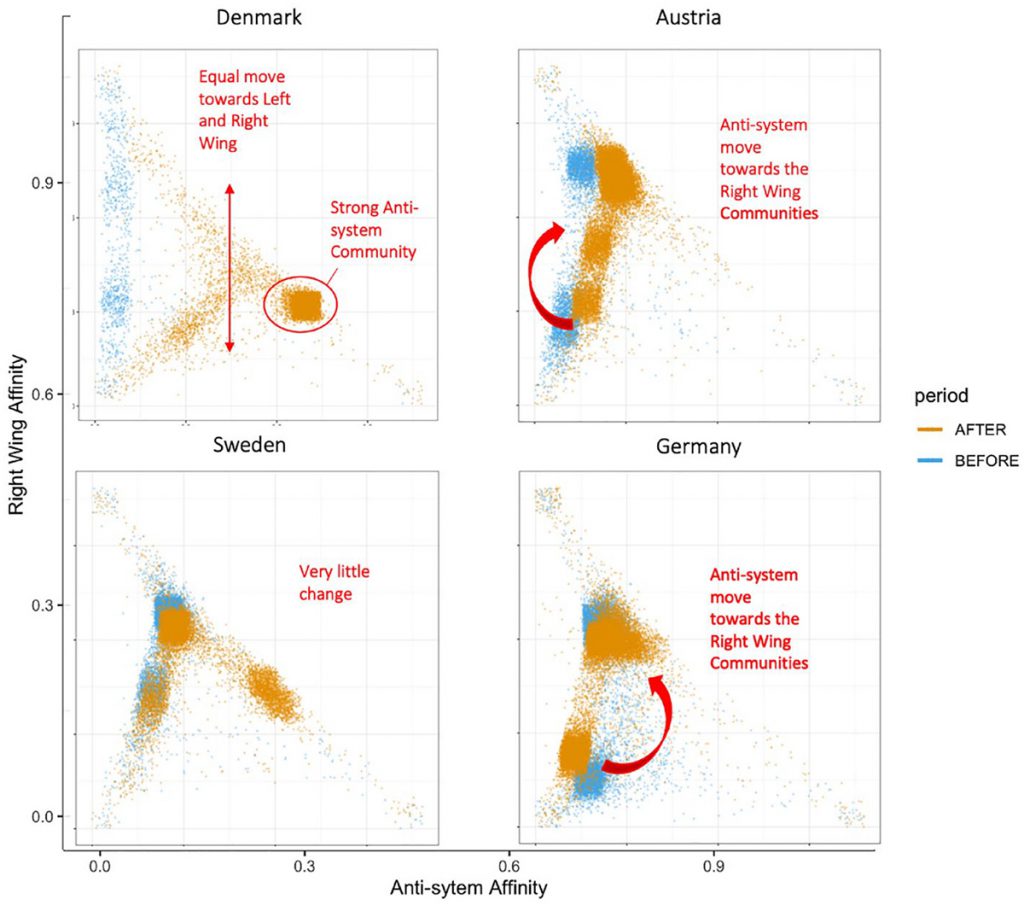Frederik Henriksen analyses anti-systemic populist movements during the Covid-19 pandemic. Here, he explains how these movements rely on alternative news media to establish their own digital information environments, and shows how ideological partisanship evolved in these echo chambers
This 🔮 Future of Populism series has rightfully challenged the tendency to categorise populism and populists as exclusively left- or right-wing. Indeed, series editors Mattia Zulianello and Petra Guasti argue that populism transcends the left/right spectrum because it can interact with, and combine, a variety of ideas.
If that is the case, should we study populism beyond the left/right spectrum, of which theoretical orientations are critical to understanding the phenomenon? Dani Filc proposes a framework relying on three dimensions for a more nuanced analysis of populism. His model addresses economic structures and policies, cultural and identity issues, and democratic conceptualisation. Notably, the second and third dimensions pertain to contemporary expressions of populism, which were particularly pronounced during the Covid-19 pandemic.
The pandemic gave rise to new protest movements that transcended the conventional left/right spectrum. Movements across the globe, including the Canadian Freedom Convoy and Germany’s Querdenken, emerged in response to perceived illegitimate, anti-democratic government interventionism in people’s lives and in all other aspects of society.
Fuelled by a blend of Covid denialism, anti-statism, anti-vaxxism, anti-scientism and conspiracy theories, these groups disseminated populist anti-establishment narratives. Through online and street-level activism, they challenged the (epistemic) authority of state officials, mainstream media, scientific experts, and global health bodies.
Movements protesting Covid restrictions challenged the authority of state officials, mainstream media, and scientific experts
These movements exemplify a particular form of ‘anti-systemic populism’ beyond the left/right spectrum. Like valence populist movements and parties, they align instead with Filc’s third democratic dimension. Anti-systemic populism uses populist communication to pit ordinary people against supposedly corrupt, failing, and/or self-interested elites. Anti-systemic populism combines this style with a range of ideas related to conspiracy theories, anti-statism, anti-vaxxism, and anti-scientism.
The phenomenon of anti-systemic populism extends beyond extra-parliamentary activism. Think of Donald Trump’s allusions to a ‘deep state’ or Wolfgang Gedeon of Germany's far-right Alternative für Deutschland claiming the virus was an American bioweapon. Both these theories exemplify anti-systemic populism in formal political discourse. The deep state conspiracy theory perceives these elites as a systemic whole, hence the ‘anti-systemic’. But it is primarily social movements led by activists, ordinary citizens, political influencers, and even reality TV celebrities, that drives the spread of this form of populist communication.
During the pandemic, anti-systemic movements established alternative information environments on many digital platforms. These environments fuelled the anti-systemic movements, while countering information from state-authorised experts and health institutions. Alternative news media were instrumental in developing and sustaining these information ecologies, reinforcing and validating the perspectives and demands of anti-systemic groups.
Alternative news media define themselves as alternatives to what they see as a deficient mainstream media landscape. They are often characterised as populist, echoing populism’s fundamental dichotomy of ‘the people’ versus ‘the elites’. While not inherently partisan, many alternative news media exhibit hyper-partisanship. They adopt a transgressive style, showing strong biases towards certain political figures, while attacking others.
Research shows that opposition to social distancing, mask-wearing and vaccination increases with exposure to alternative news media
Marcel Lewandowsky shows how partisanship can reinforce support for populist and illiberal candidates, often at the expense of democratic principles. During the pandemic, scholars found that support and opposition to social distancing, mask-wearing and vaccines were directly related to exposure to alternative news media.
One useful way to study partisanship in information environments is by partisan homophily. This is the tendency for people connect with those who share similar beliefs. Homophily can lead to the formation of echo chambers, in which like-minded individuals interact predominantly with each other. This, of course, limits their exposure to diverse viewpoints, which is vital in democratic societies for the development of a well-informed electorate.
It is natural for people to connect with others who share similar beliefs. But this limits exposure to diverse viewpoints, and risks undermining democracy
Partisan heterophily, on the other hand, denotes a willingness to engage with opinions that differ markedly from one’s own. Such cross-partisan engagement can foster political tolerance and limit polarisation. In the context of populism in wider information environments, particularly the type that fosters insular and anti-systemic movements, partisan heterophily can play a crucial role.
In collaboration with Eva Mayerhöffer and Jakob Bæk Kristensen, I researched the dynamics of partisanship within digital alternative news environments during the Covid-19 pandemic. We focused on a specific variant of heterophily known as source heterophily. This is the extent to which individuals accessed information from diverse sources, particularly those outside their usual political affiliations. Scholars have used source heterophily to explain growing polarisation in Western countries, but also to explain how biased and misconstrued worldviews gain traction.
Using digital information environments in Austria. Denmark, Germany and Sweden, we measured source heterophily as the tendency of users to disseminate a wide array of content. In the four case countries, we considered all larger platforms — Twitter-X, Facebook, Reddit, YouTube, Telegram, VKontakte, TikTok, Instagram and Gab — in one single information network. By so doing, we mitigated the risk of platform-specific biases.

Our findings revealed an interesting pattern. At the onset of the Covid-19 crisis, there was a temporary phase of cross-partisan engagement across all countries, which suggests an overall increase in source heterophily. This trend, however, was short-lived. Entrenched left/right polarities soon grew to dominate once again and, in some instances, became even more pronounced. In Germany and Austria, anti-systemic sharing communities gradually aligned with right-wing communities. This left the pre-existing partisan landscape largely intact.
Our research highlights how quickly new movements can arise during disruptive global events. It also underlines the resilience of partisanship along ideological divides over time. The findings reveal just how important it is to investigate partisanship, and to analyse and interpret the digital landscape of populist politics.
No.85 in a Loop thread on the Future of Populism. Look out for the 🔮 to read more